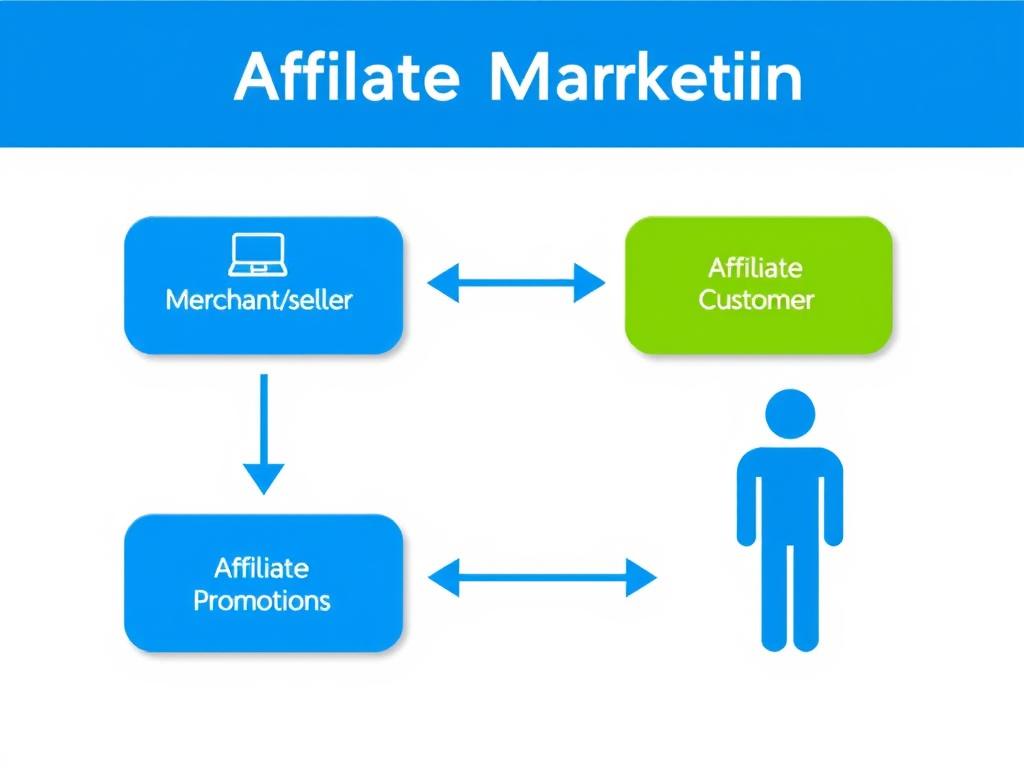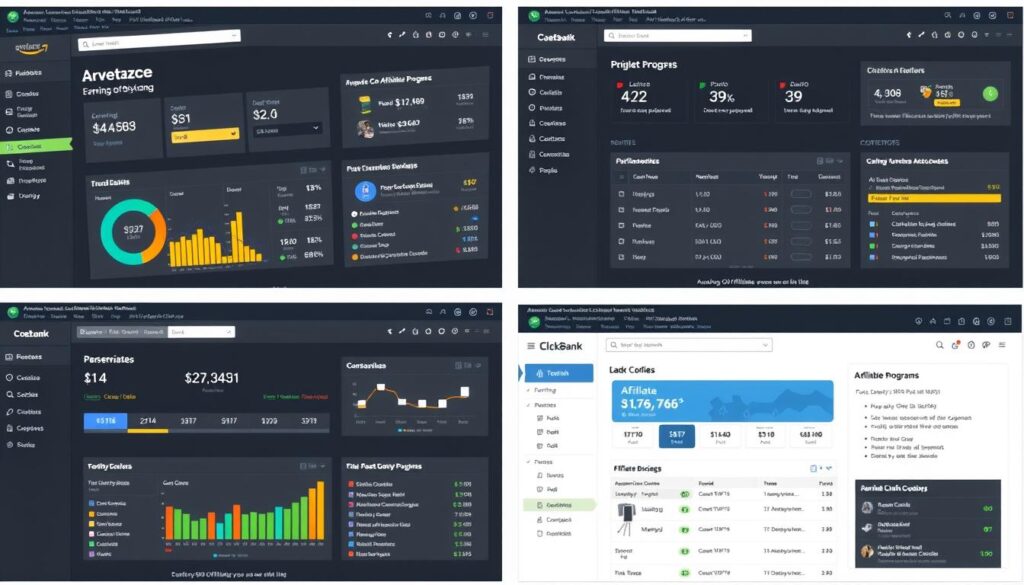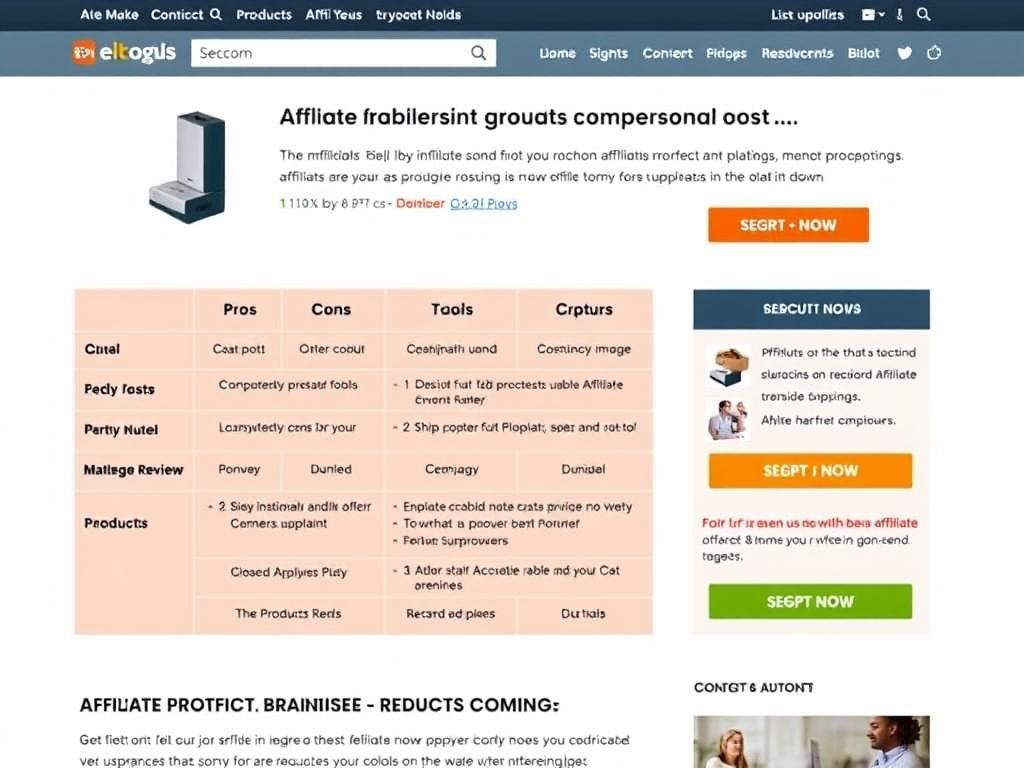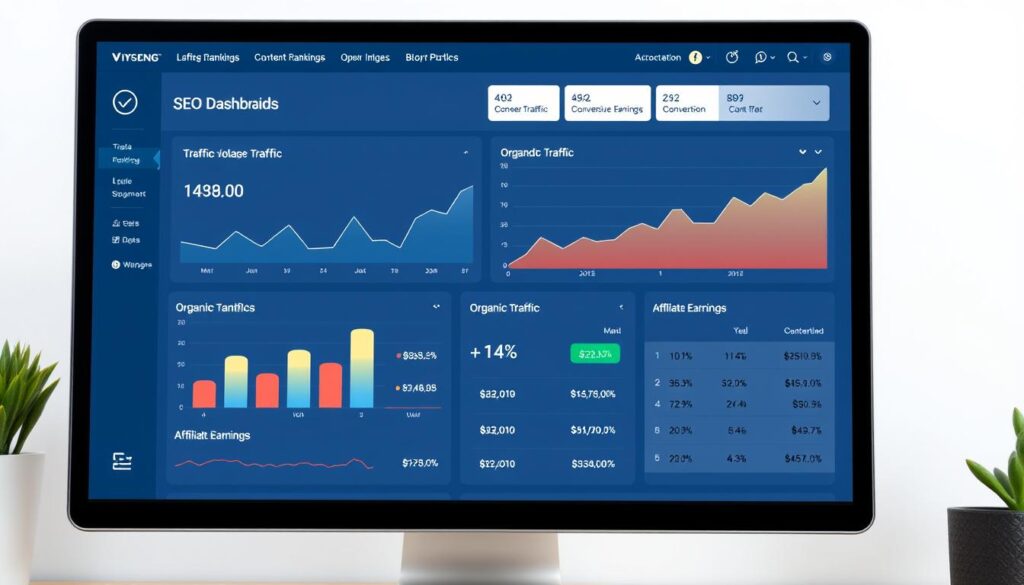What is Affiliate Marketing? A Simple Explanation
Affiliate marketing is a performance-based business model where you (the affiliate) earn a commission for promoting other companies’ products or services. When someone purchases through your unique tracking link, you receive a reward from the brand you’re promoting.
Think of it as being a digital matchmaker: you connect potential customers with products that solve their problems, and you get paid when they make a purchase. The beauty of this system is that you never have to create, stock, or ship any products yourself.

Get Your Free Affiliate Marketing Starter Kit
Download our comprehensive guide with checklists, templates, and resources to jumpstart your affiliate marketing business today.
How Affiliate Marketing Works: The Merchant-Publisher Relationship
Affiliate marketing involves three primary parties: the merchant (seller), the affiliate (publisher), and the consumer. Here’s how the relationship works:
The Merchant
Also known as the seller, vendor, or retailer, this is the company that creates or owns the product. They can range from solo entrepreneurs to large corporations like Amazon. The merchant provides affiliates with unique tracking links and pays commissions on successful referrals.
The Affiliate
Also called the publisher or promoter, this is you – the person who markets the merchant’s products to potential customers. Affiliates can be bloggers, content creators, influencers, or owners of email lists who have built an audience in a specific niche.
The Consumer
The end user who purchases the product through your affiliate link. The consumer may or may not be aware that they’re part of an affiliate marketing system, though disclosure is legally required in most countries.
Tracking Methods in Affiliate Marketing
For the affiliate marketing system to work, there needs to be a way to track which affiliates are responsible for which sales. Here are the common tracking methods:
- Cookies: When someone clicks your affiliate link, a small file called a cookie is stored on their device. This cookie contains information that identifies you as the referrer. If the person makes a purchase within the cookie’s lifetime (typically 30-90 days), you get credit.
- Unique Coupon Codes: Some programs assign unique discount codes to affiliates. When customers use your code at checkout, you receive credit for the sale.
- Unique Affiliate Links: Each affiliate gets a personalized URL that redirects to the merchant’s site while tracking the source of the referral.
- IP Tracking: Some advanced systems track the IP address of visitors who click on your links and attribute sales accordingly.
Benefits of Affiliate Marketing for All Parties
Affiliate marketing creates a win-win-win situation for merchants, affiliates, and consumers. Let’s explore the benefits for each party:
Benefits for Merchants
- Pay-for-performance model minimizes financial risk
- Expand market reach through affiliates’ audiences
- Gain access to pre-qualified, targeted traffic
- Increase brand awareness through multiple channels
- Only pay commissions after making sales
Benefits for Affiliates
- Generate passive income streams
- Start with minimal investment
- Work from anywhere with flexible hours
- No customer service responsibilities
- No product creation or inventory management
- Scale your business by promoting multiple products
Benefits for Consumers
- Discover new products through trusted sources
- Access detailed reviews and comparisons
- Often receive special discounts or bonuses
- Get expert recommendations for their needs
- Learn how to use products effectively
Pros of Affiliate Marketing
- Low startup costs and minimal financial risk
- Potential for passive income generation
- No product creation or inventory management
- Flexible work schedule and location independence
- Scalable business model with unlimited growth potential
- Performance-based rewards tied directly to your efforts
Cons of Affiliate Marketing
- Competition in popular niches can be intense
- Commission rates may fluctuate or decrease over time
- Success requires consistent content creation and promotion
- Building sufficient traffic takes time and patience
- No control over product quality or customer service
- Affiliate programs can change terms or shut down unexpectedly
How to Start Affiliate Marketing in 4 Simple Steps
Getting started with affiliate marketing doesn’t have to be complicated. Follow these four fundamental steps to build your affiliate marketing business from the ground up:
- Choose Your Niche
Select a specific market segment that you’re passionate about or knowledgeable in. The best niches have sufficient audience interest, commercial potential, and aren’t overly saturated with competition. - Build Your Platform
Create a website, blog, YouTube channel, or social media presence where you’ll share content and promote affiliate products. Your platform is the foundation of your affiliate business. - Create Valuable Content
Develop high-quality content that addresses your audience’s needs, questions, and pain points. This builds trust and positions you as an authority in your niche. - Join Affiliate Programs
Apply to relevant affiliate programs that offer products aligned with your niche and audience interests. Start promoting products that you genuinely believe in.
Selecting the Right Niche for Affiliate Marketing Success
Choosing the right niche is crucial for your affiliate marketing success. The ideal niche should be:
Profitable
Look for niches where people are willing to spend money. Research products with good commission rates and recurring revenue potential. Niches like health, wealth, and relationships typically have strong commercial intent.
Personally Interesting
Select a niche you’re genuinely interested in or knowledgeable about. Your authentic enthusiasm will shine through in your content and help you stay motivated during challenging times.
Balanced Competition
Avoid extremely competitive niches where it’s difficult to stand out. Similarly, avoid niches that are too obscure with a limited audience size. The sweet spot is a niche with reasonable competition and good audience potential.
Evergreen
Focus on topics with lasting appeal rather than temporary trends. Evergreen niches provide sustainable long-term income potential and don’t require constant content updates.
Pro Tip: Use tools like Google Trends, Ahrefs, or SEMrush to research niche popularity, competition levels, and keyword opportunities before committing to a specific market segment.
Popular Affiliate Marketing Networks and Programs
Affiliate networks act as intermediaries between merchants and affiliates, providing a platform where you can find multiple affiliate programs in one place. Here’s a comparison of some of the most popular affiliate networks:
| Network | Commission Structure | Payment Methods | Cookie Duration | Minimum Payout | Best For |
| Amazon Associates | 1-10% (product category dependent) | Direct deposit, check, Amazon gift card | 24 hours | $10 | Beginners, product reviewers |
| ShareASale | Varies by merchant (typically 5-30%) | Direct deposit, check, Payoneer | Varies (30-60 days typical) | $50 | Niche marketers, bloggers |
| Commission Junction (CJ) | Varies by merchant (typically 5-30%) | Direct deposit, check, Payoneer | Varies (30 days typical) | $50 | Experienced affiliates, high-volume sites |
| ClickBank | Typically 30-75% | Direct deposit, check, wire transfer | 60 days | $10 | Digital product promoters |
| Impact | Varies by merchant | Direct deposit, PayPal | Varies by merchant | Varies by merchant | SaaS, subscription services |

Download Our Affiliate Network Comparison Guide
Get our detailed breakdown of 20+ affiliate networks with insider tips on acceptance criteria, payment terms, and highest-converting merchants.
Commission Structures Across Different Niches
Commission rates vary significantly across different industries and product types. Understanding these differences can help you select niches with the best income potential:
| Niche/Industry | Average Commission Rate | Commission Type | Earning Potential |
| Physical Products (General) | 1-10% | One-time | Medium |
| Digital Products/Courses | 30-50% | One-time | High |
| SaaS/Subscription Services | 20-40% | Recurring | Very High |
| Financial Services | $50-$100+ per lead | CPA (Cost Per Action) | High |
| Web Hosting | $50-$150 per sale | One-time or Recurring | High |
| Travel | 2-5% | One-time | Medium |
Affiliate Marketing Content Creation Strategies
Creating high-quality, engaging content is the cornerstone of successful affiliate marketing. The right content builds trust with your audience and naturally incorporates your affiliate promotions. Here are effective content types for affiliate marketers:

Product Reviews
Detailed, honest assessments of products you’ve personally used. Effective reviews highlight both pros and cons while explaining how the product solved a specific problem.
Comparison Posts
Side-by-side evaluations of similar products, helping readers make informed decisions between alternatives. These posts target buyers who are close to making a purchase decision.
Tutorial Content
Step-by-step guides that teach readers how to accomplish something while naturally incorporating affiliate products as recommended tools or resources.
Resource Pages
Curated collections of the best tools, products, or services in your niche. These evergreen pages continue generating affiliate commissions over time with minimal updates.
Case Studies
Real-world examples showing how you or others achieved specific results using particular products or services, providing concrete evidence of their effectiveness.
Email Sequences
Targeted email campaigns that nurture subscribers through educational content before presenting relevant affiliate offers at the appropriate time.
Creating Content That Converts: Best Practices
- Focus on solving problems: Address specific pain points your audience experiences and position affiliate products as solutions.
- Be transparent and honest: Always disclose your affiliate relationships and provide balanced reviews that include both positives and negatives.
- Use your own experience: Whenever possible, personally test products before recommending them to build authentic, trustworthy content.
- Include visual elements: Incorporate images, videos, screenshots, and demonstrations to enhance your content and showcase products in action.
- Create detailed content: In-depth, comprehensive content typically outperforms brief overviews in both search rankings and conversion rates.
- Add clear calls-to-action: Guide readers with specific next steps and clear directions on how to purchase or learn more about recommended products.

Effective Affiliate Marketing Promotion Strategies
Creating great content is only half the battle – you also need to get it in front of your target audience. Here are proven strategies to promote your affiliate content and drive more conversions:
SEO: The Foundation of Affiliate Marketing Traffic
Search engine optimization helps your content rank higher in search results, bringing free, targeted traffic to your affiliate offers:
- Keyword research: Identify search terms with commercial intent that your target audience is using.
- On-page optimization: Structure your content with proper headings, meta descriptions, and naturally incorporated keywords.
- Technical SEO: Ensure your site loads quickly, is mobile-friendly, and has a clean structure that search engines can easily crawl.
- Link building: Develop a strategy to earn backlinks from reputable sites in your niche to boost your domain authority.

Email Marketing for Affiliate Promotions
Email marketing remains one of the most effective channels for affiliate promotions, offering direct access to an engaged audience:
- Build a targeted list: Create lead magnets specific to your niche to attract subscribers interested in your affiliate products.
- Segment your audience: Divide subscribers based on interests and behaviors to send more relevant affiliate offers.
- Value-first approach: Provide valuable content in most emails, with occasional promotional messages.
- Strategic sequences: Create automated email sequences that educate subscribers before introducing affiliate products.
Social Media Strategies for Affiliate Marketers
Different social platforms offer unique opportunities for affiliate promotion:
Create visually appealing pins linking to your affiliate content. Focus on product-focused boards and lifestyle imagery that showcases products in use. Pinterest users often have high purchase intent, making it ideal for affiliate marketing.
YouTube
Create product reviews, tutorials, and unboxing videos with affiliate links in the description. Video content builds stronger trust and allows you to demonstrate products in action, leading to higher conversion rates.
Use a combination of feed posts, Stories, and Reels to showcase affiliate products. Leverage the “link in bio” feature or Shopping tags for direct affiliate promotion. Focus on authentic, lifestyle-oriented content.

| Key Metric | Description | Target Range | How to Improve |
| Conversion Rate (CR) | Percentage of visitors who click your affiliate link and complete a purchase | 1-5% | Improve content quality, target higher-intent keywords, enhance product/audience match |
| Earnings Per Click (EPC) | Average earnings generated per click on your affiliate links | $0.50-$2.00 | Promote higher-commission products, improve pre-selling content, target warmer audiences |
| Click-Through Rate (CTR) | Percentage of page visitors who click on your affiliate links | 2-8% | Improve link placement, use compelling CTAs, enhance link visibility |
| Return on Investment (ROI) | Revenue generated compared to costs (time, money) invested | 200%+ | Focus on higher-converting content types, scale successful campaigns, reduce costs |
Common Affiliate Marketing Mistakes to Avoid
Even experienced marketers can fall into these common traps. Being aware of these pitfalls will help you build a more sustainable and profitable affiliate business:

Promoting Too Many Products
Focusing on too many affiliate products dilutes your message and confuses your audience. Instead, concentrate on a select few high-quality products that you genuinely believe in and can promote authentically.
Ignoring FTC Disclosure Requirements
Failing to disclose your affiliate relationships is not only unethical but potentially illegal. Always clearly disclose that you earn commissions from your recommendations in a prominent location.
Choosing Products Based Only on Commissions
Selecting products solely because they offer high commission rates often leads to promoting items that don’t truly serve your audience’s needs, damaging your credibility and trust.
Insufficient Product Research
Recommending products you haven’t personally tested or thoroughly researched can backfire if your audience purchases something that doesn’t deliver on your promises.
Neglecting Email List Building
Relying solely on search or social traffic without building an email list means you’re missing out on your most valuable asset – a direct communication channel with your audience.
Expecting Overnight Success
Affiliate marketing requires consistent effort over time. Many beginners give up too soon, not realizing that building traffic and trust typically takes months, not days or weeks.
“The biggest mistake I see new affiliate marketers make is jumping from product to product, niche to niche, without giving any single approach enough time to gain traction. Success in this business comes from consistency and patience.”
Important: Always check the terms and conditions of each affiliate program you join. Some have strict rules about how and where you can promote their products. Violating these terms can result in account termination and lost commissions.
Future Trends in Affiliate Marketing for 2024 and Beyond
The affiliate marketing landscape continues to evolve. Staying ahead of these trends will give you a competitive advantage:

AI and Automation
Artificial intelligence is transforming affiliate marketing through personalized product recommendations, automated content creation, and sophisticated targeting. Smart affiliates are leveraging AI tools to analyze performance data and optimize campaigns while focusing their human creativity on strategy and relationship building.
Voice Search Optimization
As voice-activated devices become more prevalent, affiliates need to optimize content for conversational queries. This means focusing on natural language, question-based content, and local search optimization to capture traffic from voice searches.
Video Content Dominance
Video continues to outperform text-based content in engagement and conversion rates. Successful affiliates are creating product reviews, tutorials, and comparisons in video format across platforms like YouTube, TikTok, and Instagram to build stronger connections with their audience.
Influencer-Affiliate Hybrid Models
The line between influencer marketing and affiliate marketing is blurring. More brands are offering hybrid compensation models that combine flat fees with performance-based commissions, creating new opportunities for content creators with engaged audiences.
Mobile-First Strategies
With mobile commerce continuing to grow, successful affiliates are prioritizing mobile-optimized content and user experiences. This includes faster loading times, simplified checkout processes, and content formats designed specifically for mobile consumption.
Increased Transparency and Authenticity
Consumers are becoming more discerning about affiliate recommendations. The most successful affiliates are embracing radical transparency, sharing both positive and negative aspects of products and focusing on authentic, value-driven content.
Industry Insight: According to recent projections, affiliate marketing spending in the United States is expected to reach approximately $12 billion by 2025, up from $9.56 billion in 2023. This growth reflects the increasing value brands place on performance-based marketing channels.
Frequently Asked Questions About Affiliate Marketing
How much money can I make with affiliate marketing?
Affiliate marketing income varies widely based on factors like your niche, audience size, content quality, and promotion strategies. Beginners might earn $100-$500 per month, while experienced affiliate marketers with established platforms can earn $10,000+ monthly. The key is to set realistic expectations and focus on consistent growth rather than overnight success.
Do I need a website to start affiliate marketing?
While having your website provides the most control and long-term benefits, it’s not necessary to start. You can begin affiliate marketing using platforms like YouTube, Instagram, or TikTok. However, most successful affiliate marketers eventually build their website to maximize earnings potential, own their audience, and diversify traffic sources.
Is affiliate marketing still profitable in 2024?
Yes, affiliate marketing remains highly profitable in 2024, though the landscape has evolved. While competition has increased in popular niches, so has consumer online spending. Success today requires higher-quality content, a focus on building trust, and adapting to new technologies and platforms. Affiliates who provide genuine value and build authentic connections with their audience continue to thrive.

Start Your Affiliate Marketing Journey Today
Affiliate marketing offers a flexible, scalable way to generate passive income online by connecting your audience with products and services that solve their problems. While it requires patience and consistent effort, the potential rewards – financial freedom, location independence, and building a business around your passions – make it well worth pursuing.
Remember that successful affiliate marketing is built on a foundation of trust and value. Focus first on serving your audience with honest, helpful content, and the commissions will follow naturally. Start small, learn continuously, and scale what works.

Ready to Build Your Affiliate Marketing Business?
Download our comprehensive Affiliate Marketing Success Roadmap with step-by-step guidance, templates, and resources to fast-track your journey.
